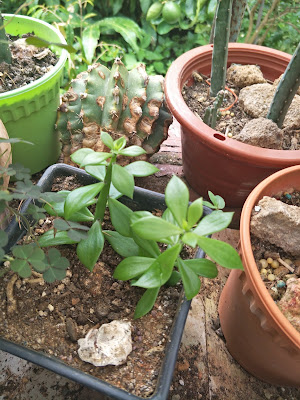What is Pereskiopsis
The shape of Pereskiopsis is not that of a typical cactus, since it has large green leaves and grows like a bush. It is identified as a cactus based on the presence of areoles, spines, glochids and flower.
Pereskiopsis is often used as a grafting stock for other cactus, as it promotes quick growth of the scion. Its small diameter makes it an excellent grafting stock for the small seedlings but many species will outgrow the stock and need to be re-grafted or rooted. Pereskiopsis is a tropical cactus and can not withstand frost or cold environment.
The glochids are dense points of small spines (like on an Opuntia cactus) on the stems which pull away when touched and get lodged in the skin. They can be extremely annoying and painful, so wear gloves or use a rag to handle the cactus when grafting. A trick we use is to pluck off a leaf from the stock and use it to poke the glochids, they become attached to the leaf and can be thrown away.
You can easily propagate Pereskiopsis through cuttings, they root in under 2 days if healthy. Basically, if you begin with five cutting, you may end up with 50 to 100 cuttings in a year. they multiplied quickly through side branching and grafting leftovers.
Below is the picture of their normal size around 1 month after getting rooted, leftover from previous graft.
How To Graft On Pereskiopsis
Basically you have two choice for Pereskiopsis graft, one is normal slab graft and the other one is impale graft.
What I would like to share today is impale graft due to its better success rate.
Step 1
Cut the top 1 to 2 inch of the root stock and remove the areoles which consist of spikes and leaves. This is a must to avoid offshoot coming through the scion
Step 2
Sharpen the cut like into a pencil shape and make sure the cut is moist, avoid taking too long for each step.
Step 3
Make a hole on your scion right at the vascular ring and impale it to the pointy end of rootstock. You have the option of wrapping the whole union with plastic wrap to ensure no movement to disrupts the grafts. However, based on the scion weight, I let them as they are.
Pro vs Con of Pereskiopsis Graft
Pro
1. Best growth rate among the available rootstocks, it perform far faster than Hylocereus but up to a certain scion size grown.
2. Suitable for seedling and small scion graft.
3. Take up small space and can fit multiple plants per pot
4. The leaves contain a lot of sap that usable on Pereskiopsis graft and other rootstocks too.
5. Fast result, you can see whether it fail or succeed in a matter of 2-4 days.
6. Fast rooting ability, you can graft a week after rooting the cutting
7. Quick propagation and replication, allows greater number of rootstock available in short time.
8. Low cost to grow and graft.
9. You can use multiple rootstock on a medium size scion to get turbo like growth.
Cons
1. A lot of spikes and glochids makes them hard to handle and graft to beginner
2. Tend to push sideshoots and need regular monitoring
3. Need regular watering
4. Need to re-graft or rooting the scion in less than 2 years or the growth rate is too slow
5. The union is sunk in too deep inside the scion, need to dig deeper to remove all rootstock remains
6. Generally does not suit big scion for grafting
Grafting Results
Easy and quick grafting session with Lophophora scions
Astrophytum myriostigma onzuka scion grafted 4 weeks after germination
Cuttings left from the grafting sessions are rooted and will be ready to be grafted for the next month.
And lastly, You tube version of Pereskiopsis grafting.
Thanks for reading and happy growing guys.
Adieu










No comments:
Post a Comment